A Critical Literature Review on the Complexities of Food Deserts
VerifiedAdded on 2022/08/12
|6
|1554
|27
Literature Review
AI Summary
This literature review examines the concept of food deserts through an analysis of several academic articles and one media artifact. The review covers various perspectives on measuring food access, the perceptions of food environments by residents in urban food deserts, and the unique challenges of food deserts in Africa. It also discusses the role of neoliberal governance in addressing obesity and the causes of nutritional inequality in the United States, highlighting the importance of education and nutritional knowledge. The review further explores the theory behind food deserts, suggesting solutions such as community gardens and improved access to transportation, and analyzes the eating habits in food deserts using Instagram data. The included studies emphasize the need for a comprehensive understanding of food access that goes beyond proximity to supermarkets and considers factors like price, transportation, and cultural influences.
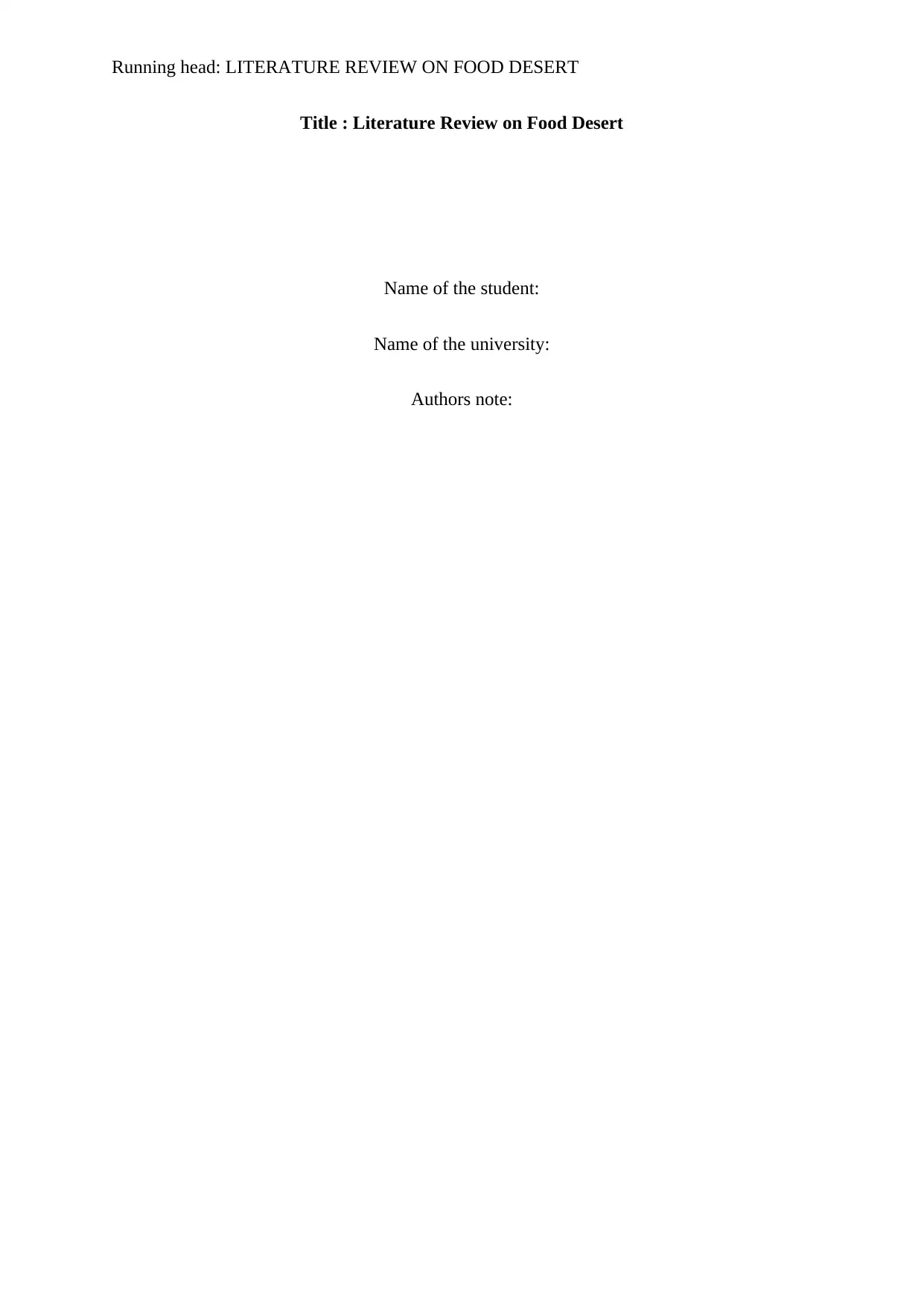
Running head: LITERATURE REVIEW ON FOOD DESERT
Title : Literature Review on Food Desert
Name of the student:
Name of the university:
Authors note:
Title : Literature Review on Food Desert
Name of the student:
Name of the university:
Authors note:
Secure Best Marks with AI Grader
Need help grading? Try our AI Grader for instant feedback on your assignments.
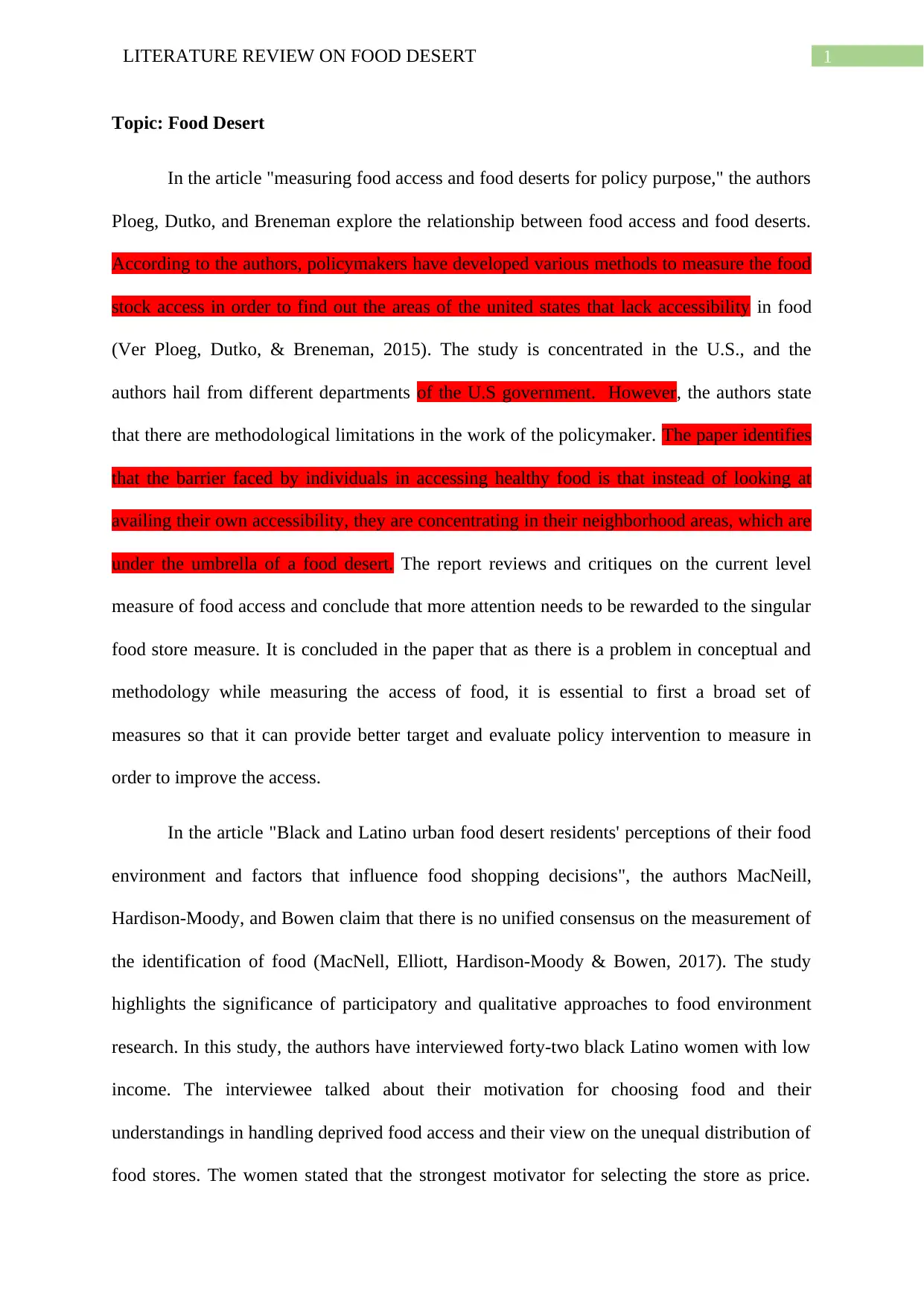
1LITERATURE REVIEW ON FOOD DESERT
Topic: Food Desert
In the article "measuring food access and food deserts for policy purpose," the authors
Ploeg, Dutko, and Breneman explore the relationship between food access and food deserts.
According to the authors, policymakers have developed various methods to measure the food
stock access in order to find out the areas of the united states that lack accessibility in food
(Ver Ploeg, Dutko, & Breneman, 2015). The study is concentrated in the U.S., and the
authors hail from different departments of the U.S government. However, the authors state
that there are methodological limitations in the work of the policymaker. The paper identifies
that the barrier faced by individuals in accessing healthy food is that instead of looking at
availing their own accessibility, they are concentrating in their neighborhood areas, which are
under the umbrella of a food desert. The report reviews and critiques on the current level
measure of food access and conclude that more attention needs to be rewarded to the singular
food store measure. It is concluded in the paper that as there is a problem in conceptual and
methodology while measuring the access of food, it is essential to first a broad set of
measures so that it can provide better target and evaluate policy intervention to measure in
order to improve the access.
In the article "Black and Latino urban food desert residents' perceptions of their food
environment and factors that influence food shopping decisions", the authors MacNeill,
Hardison-Moody, and Bowen claim that there is no unified consensus on the measurement of
the identification of food (MacNell, Elliott, Hardison-Moody & Bowen, 2017). The study
highlights the significance of participatory and qualitative approaches to food environment
research. In this study, the authors have interviewed forty-two black Latino women with low
income. The interviewee talked about their motivation for choosing food and their
understandings in handling deprived food access and their view on the unequal distribution of
food stores. The women stated that the strongest motivator for selecting the store as price.
Topic: Food Desert
In the article "measuring food access and food deserts for policy purpose," the authors
Ploeg, Dutko, and Breneman explore the relationship between food access and food deserts.
According to the authors, policymakers have developed various methods to measure the food
stock access in order to find out the areas of the united states that lack accessibility in food
(Ver Ploeg, Dutko, & Breneman, 2015). The study is concentrated in the U.S., and the
authors hail from different departments of the U.S government. However, the authors state
that there are methodological limitations in the work of the policymaker. The paper identifies
that the barrier faced by individuals in accessing healthy food is that instead of looking at
availing their own accessibility, they are concentrating in their neighborhood areas, which are
under the umbrella of a food desert. The report reviews and critiques on the current level
measure of food access and conclude that more attention needs to be rewarded to the singular
food store measure. It is concluded in the paper that as there is a problem in conceptual and
methodology while measuring the access of food, it is essential to first a broad set of
measures so that it can provide better target and evaluate policy intervention to measure in
order to improve the access.
In the article "Black and Latino urban food desert residents' perceptions of their food
environment and factors that influence food shopping decisions", the authors MacNeill,
Hardison-Moody, and Bowen claim that there is no unified consensus on the measurement of
the identification of food (MacNell, Elliott, Hardison-Moody & Bowen, 2017). The study
highlights the significance of participatory and qualitative approaches to food environment
research. In this study, the authors have interviewed forty-two black Latino women with low
income. The interviewee talked about their motivation for choosing food and their
understandings in handling deprived food access and their view on the unequal distribution of
food stores. The women stated that the strongest motivator for selecting the store as price.
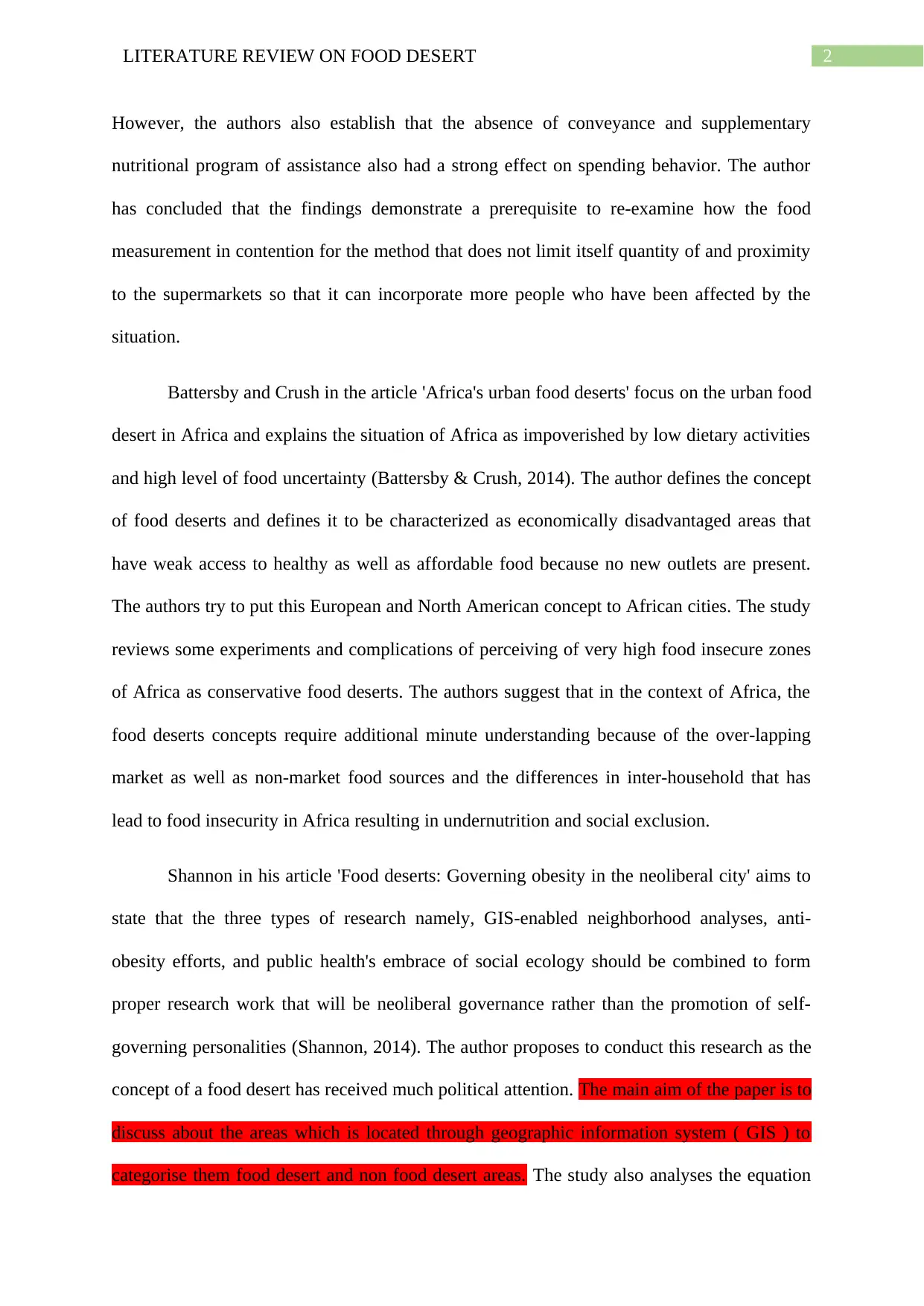
2LITERATURE REVIEW ON FOOD DESERT
However, the authors also establish that the absence of conveyance and supplementary
nutritional program of assistance also had a strong effect on spending behavior. The author
has concluded that the findings demonstrate a prerequisite to re-examine how the food
measurement in contention for the method that does not limit itself quantity of and proximity
to the supermarkets so that it can incorporate more people who have been affected by the
situation.
Battersby and Crush in the article 'Africa's urban food deserts' focus on the urban food
desert in Africa and explains the situation of Africa as impoverished by low dietary activities
and high level of food uncertainty (Battersby & Crush, 2014). The author defines the concept
of food deserts and defines it to be characterized as economically disadvantaged areas that
have weak access to healthy as well as affordable food because no new outlets are present.
The authors try to put this European and North American concept to African cities. The study
reviews some experiments and complications of perceiving of very high food insecure zones
of Africa as conservative food deserts. The authors suggest that in the context of Africa, the
food deserts concepts require additional minute understanding because of the over-lapping
market as well as non-market food sources and the differences in inter-household that has
lead to food insecurity in Africa resulting in undernutrition and social exclusion.
Shannon in his article 'Food deserts: Governing obesity in the neoliberal city' aims to
state that the three types of research namely, GIS-enabled neighborhood analyses, anti-
obesity efforts, and public health's embrace of social ecology should be combined to form
proper research work that will be neoliberal governance rather than the promotion of self-
governing personalities (Shannon, 2014). The author proposes to conduct this research as the
concept of a food desert has received much political attention. The main aim of the paper is to
discuss about the areas which is located through geographic information system ( GIS ) to
categorise them food desert and non food desert areas. The study also analyses the equation
However, the authors also establish that the absence of conveyance and supplementary
nutritional program of assistance also had a strong effect on spending behavior. The author
has concluded that the findings demonstrate a prerequisite to re-examine how the food
measurement in contention for the method that does not limit itself quantity of and proximity
to the supermarkets so that it can incorporate more people who have been affected by the
situation.
Battersby and Crush in the article 'Africa's urban food deserts' focus on the urban food
desert in Africa and explains the situation of Africa as impoverished by low dietary activities
and high level of food uncertainty (Battersby & Crush, 2014). The author defines the concept
of food deserts and defines it to be characterized as economically disadvantaged areas that
have weak access to healthy as well as affordable food because no new outlets are present.
The authors try to put this European and North American concept to African cities. The study
reviews some experiments and complications of perceiving of very high food insecure zones
of Africa as conservative food deserts. The authors suggest that in the context of Africa, the
food deserts concepts require additional minute understanding because of the over-lapping
market as well as non-market food sources and the differences in inter-household that has
lead to food insecurity in Africa resulting in undernutrition and social exclusion.
Shannon in his article 'Food deserts: Governing obesity in the neoliberal city' aims to
state that the three types of research namely, GIS-enabled neighborhood analyses, anti-
obesity efforts, and public health's embrace of social ecology should be combined to form
proper research work that will be neoliberal governance rather than the promotion of self-
governing personalities (Shannon, 2014). The author proposes to conduct this research as the
concept of a food desert has received much political attention. The main aim of the paper is to
discuss about the areas which is located through geographic information system ( GIS ) to
categorise them food desert and non food desert areas. The study also analyses the equation
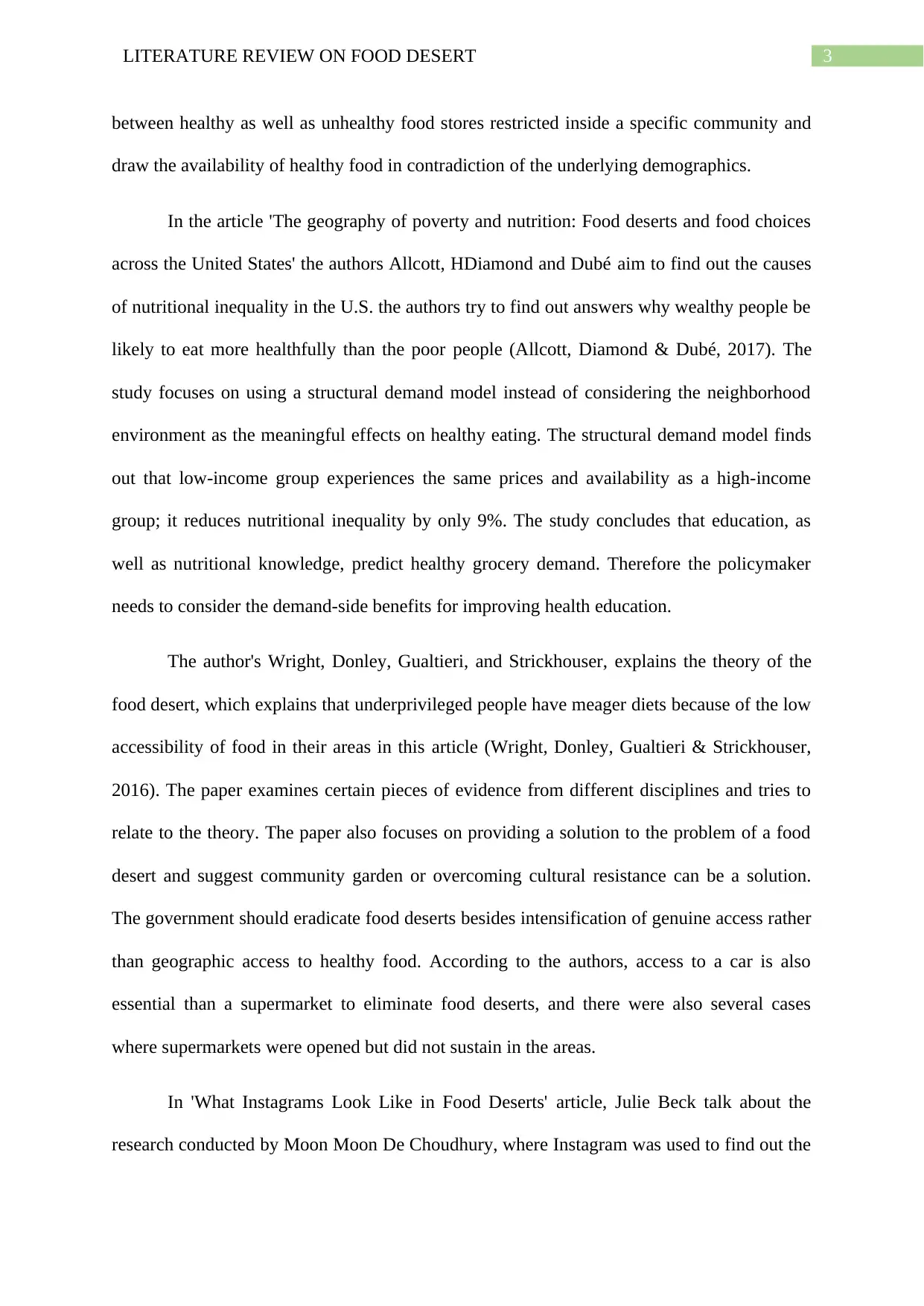
3LITERATURE REVIEW ON FOOD DESERT
between healthy as well as unhealthy food stores restricted inside a specific community and
draw the availability of healthy food in contradiction of the underlying demographics.
In the article 'The geography of poverty and nutrition: Food deserts and food choices
across the United States' the authors Allcott, HDiamond and Dubé aim to find out the causes
of nutritional inequality in the U.S. the authors try to find out answers why wealthy people be
likely to eat more healthfully than the poor people (Allcott, Diamond & Dubé, 2017). The
study focuses on using a structural demand model instead of considering the neighborhood
environment as the meaningful effects on healthy eating. The structural demand model finds
out that low-income group experiences the same prices and availability as a high-income
group; it reduces nutritional inequality by only 9%. The study concludes that education, as
well as nutritional knowledge, predict healthy grocery demand. Therefore the policymaker
needs to consider the demand-side benefits for improving health education.
The author's Wright, Donley, Gualtieri, and Strickhouser, explains the theory of the
food desert, which explains that underprivileged people have meager diets because of the low
accessibility of food in their areas in this article (Wright, Donley, Gualtieri & Strickhouser,
2016). The paper examines certain pieces of evidence from different disciplines and tries to
relate to the theory. The paper also focuses on providing a solution to the problem of a food
desert and suggest community garden or overcoming cultural resistance can be a solution.
The government should eradicate food deserts besides intensification of genuine access rather
than geographic access to healthy food. According to the authors, access to a car is also
essential than a supermarket to eliminate food deserts, and there were also several cases
where supermarkets were opened but did not sustain in the areas.
In 'What Instagrams Look Like in Food Deserts' article, Julie Beck talk about the
research conducted by Moon Moon De Choudhury, where Instagram was used to find out the
between healthy as well as unhealthy food stores restricted inside a specific community and
draw the availability of healthy food in contradiction of the underlying demographics.
In the article 'The geography of poverty and nutrition: Food deserts and food choices
across the United States' the authors Allcott, HDiamond and Dubé aim to find out the causes
of nutritional inequality in the U.S. the authors try to find out answers why wealthy people be
likely to eat more healthfully than the poor people (Allcott, Diamond & Dubé, 2017). The
study focuses on using a structural demand model instead of considering the neighborhood
environment as the meaningful effects on healthy eating. The structural demand model finds
out that low-income group experiences the same prices and availability as a high-income
group; it reduces nutritional inequality by only 9%. The study concludes that education, as
well as nutritional knowledge, predict healthy grocery demand. Therefore the policymaker
needs to consider the demand-side benefits for improving health education.
The author's Wright, Donley, Gualtieri, and Strickhouser, explains the theory of the
food desert, which explains that underprivileged people have meager diets because of the low
accessibility of food in their areas in this article (Wright, Donley, Gualtieri & Strickhouser,
2016). The paper examines certain pieces of evidence from different disciplines and tries to
relate to the theory. The paper also focuses on providing a solution to the problem of a food
desert and suggest community garden or overcoming cultural resistance can be a solution.
The government should eradicate food deserts besides intensification of genuine access rather
than geographic access to healthy food. According to the authors, access to a car is also
essential than a supermarket to eliminate food deserts, and there were also several cases
where supermarkets were opened but did not sustain in the areas.
In 'What Instagrams Look Like in Food Deserts' article, Julie Beck talk about the
research conducted by Moon Moon De Choudhury, where Instagram was used to find out the
Secure Best Marks with AI Grader
Need help grading? Try our AI Grader for instant feedback on your assignments.

4LITERATURE REVIEW ON FOOD DESERT
eating habit of the desert zone and non-desert zone (The Atlantic, 2020). The researcher's
groups categorized the food using the united state department of agriculture. It was observed
that the food from the food desert region had high cholesterol, sugar, and fat than the areas of
the non-food desert region. The nutritional value of the food desert region was much lesser
than the non-food desert region. However, the research is critiqued on the basis that people
choose to show their life in a certain way in social media, stating that it may not honestly
indicate eating habits. Though De Choudhury explains that this research shows the
accessibility of food in these regions.
eating habit of the desert zone and non-desert zone (The Atlantic, 2020). The researcher's
groups categorized the food using the united state department of agriculture. It was observed
that the food from the food desert region had high cholesterol, sugar, and fat than the areas of
the non-food desert region. The nutritional value of the food desert region was much lesser
than the non-food desert region. However, the research is critiqued on the basis that people
choose to show their life in a certain way in social media, stating that it may not honestly
indicate eating habits. Though De Choudhury explains that this research shows the
accessibility of food in these regions.
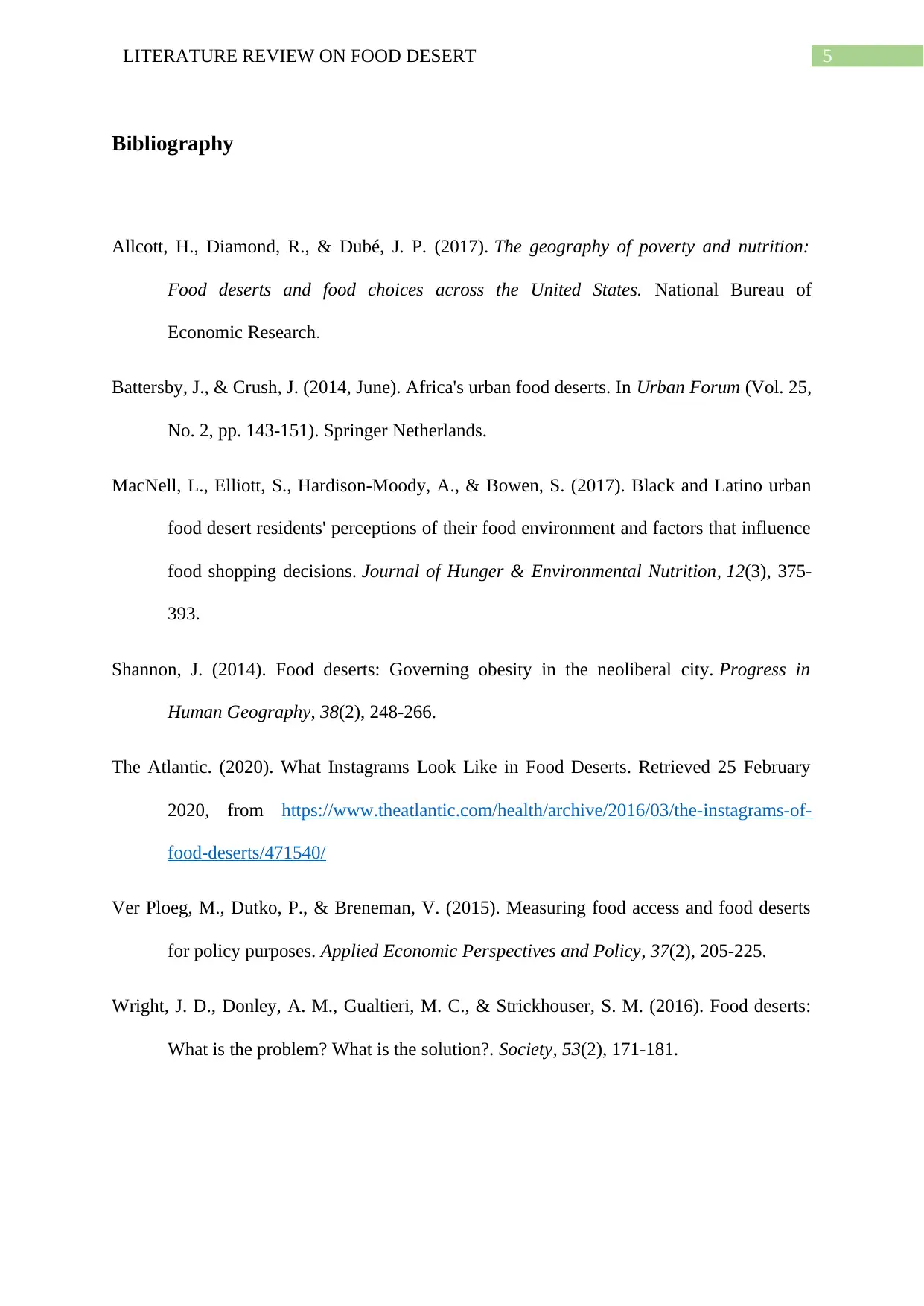
5LITERATURE REVIEW ON FOOD DESERT
Bibliography
Allcott, H., Diamond, R., & Dubé, J. P. (2017). The geography of poverty and nutrition:
Food deserts and food choices across the United States. National Bureau of
Economic Research.
Battersby, J., & Crush, J. (2014, June). Africa's urban food deserts. In Urban Forum (Vol. 25,
No. 2, pp. 143-151). Springer Netherlands.
MacNell, L., Elliott, S., Hardison-Moody, A., & Bowen, S. (2017). Black and Latino urban
food desert residents' perceptions of their food environment and factors that influence
food shopping decisions. Journal of Hunger & Environmental Nutrition, 12(3), 375-
393.
Shannon, J. (2014). Food deserts: Governing obesity in the neoliberal city. Progress in
Human Geography, 38(2), 248-266.
The Atlantic. (2020). What Instagrams Look Like in Food Deserts. Retrieved 25 February
2020, from https://www.theatlantic.com/health/archive/2016/03/the-instagrams-of-
food-deserts/471540/
Ver Ploeg, M., Dutko, P., & Breneman, V. (2015). Measuring food access and food deserts
for policy purposes. Applied Economic Perspectives and Policy, 37(2), 205-225.
Wright, J. D., Donley, A. M., Gualtieri, M. C., & Strickhouser, S. M. (2016). Food deserts:
What is the problem? What is the solution?. Society, 53(2), 171-181.
Bibliography
Allcott, H., Diamond, R., & Dubé, J. P. (2017). The geography of poverty and nutrition:
Food deserts and food choices across the United States. National Bureau of
Economic Research.
Battersby, J., & Crush, J. (2014, June). Africa's urban food deserts. In Urban Forum (Vol. 25,
No. 2, pp. 143-151). Springer Netherlands.
MacNell, L., Elliott, S., Hardison-Moody, A., & Bowen, S. (2017). Black and Latino urban
food desert residents' perceptions of their food environment and factors that influence
food shopping decisions. Journal of Hunger & Environmental Nutrition, 12(3), 375-
393.
Shannon, J. (2014). Food deserts: Governing obesity in the neoliberal city. Progress in
Human Geography, 38(2), 248-266.
The Atlantic. (2020). What Instagrams Look Like in Food Deserts. Retrieved 25 February
2020, from https://www.theatlantic.com/health/archive/2016/03/the-instagrams-of-
food-deserts/471540/
Ver Ploeg, M., Dutko, P., & Breneman, V. (2015). Measuring food access and food deserts
for policy purposes. Applied Economic Perspectives and Policy, 37(2), 205-225.
Wright, J. D., Donley, A. M., Gualtieri, M. C., & Strickhouser, S. M. (2016). Food deserts:
What is the problem? What is the solution?. Society, 53(2), 171-181.
1 out of 6
Your All-in-One AI-Powered Toolkit for Academic Success.
+13062052269
info@desklib.com
Available 24*7 on WhatsApp / Email
![[object Object]](/_next/static/media/star-bottom.7253800d.svg)
Unlock your academic potential
© 2024 | Zucol Services PVT LTD | All rights reserved.